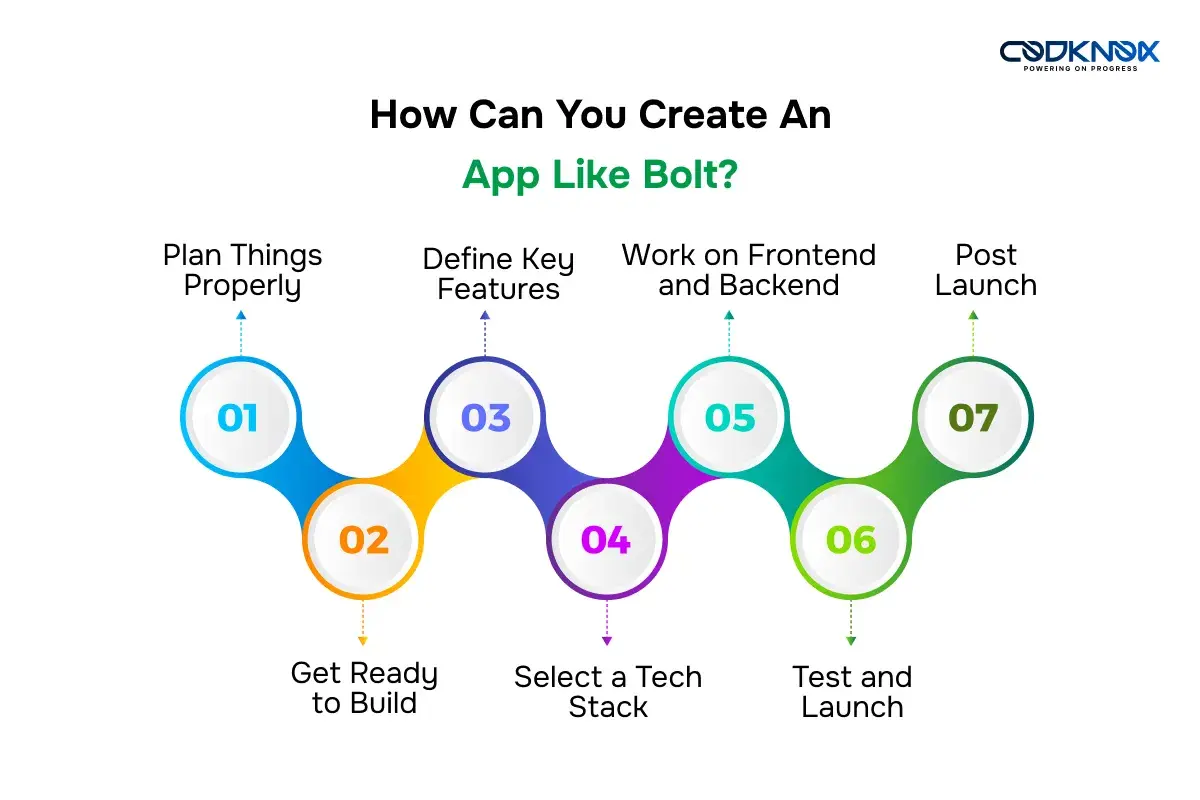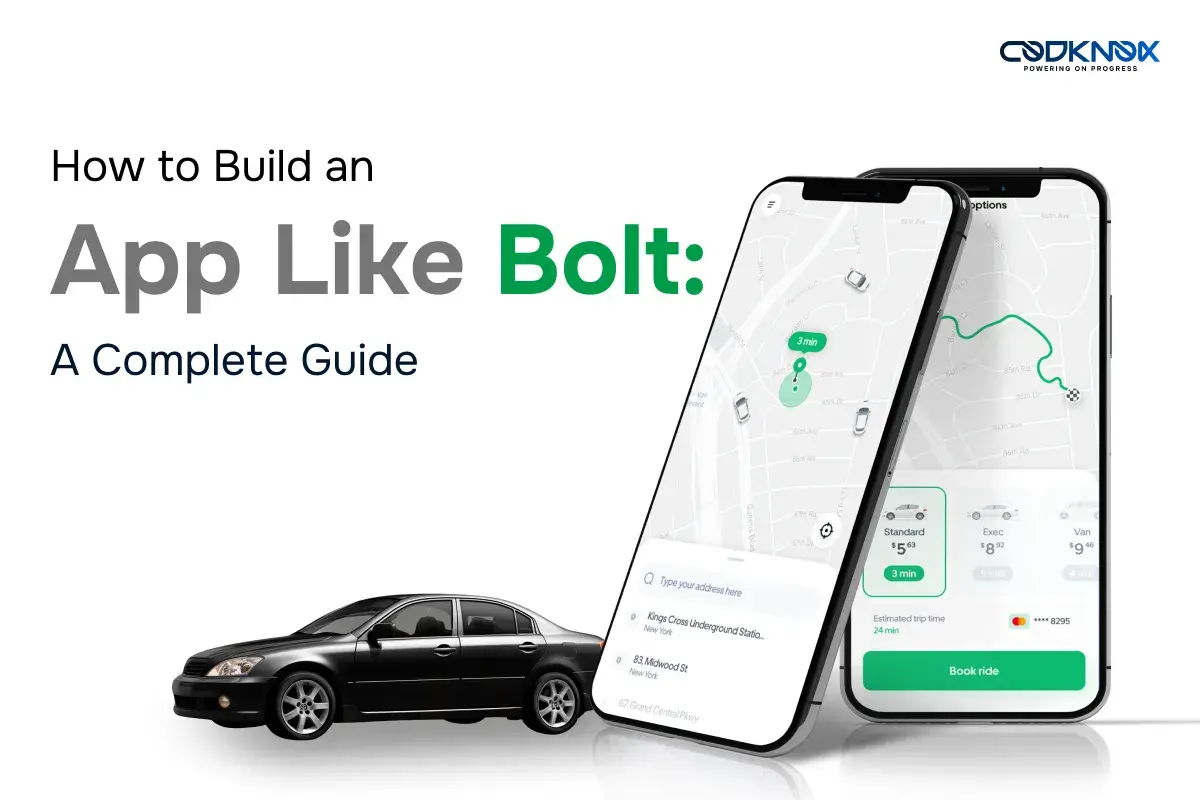With digitalization, services like Bolt have transformed the field of transportation by offering accessible, affordable ride ordering via mobile apps. Considering this transformation, it is expected that the ride-hailing industry worth $196.05 billion in 2021 will grow to $515.49 billion by 2030- growing 11.34% annually from 2022 to 2030.
Thus, inspired by Bolt’s success, several entrepreneurs aim to enter this lucrative market with ride-hailing apps like Bolt. However, creating a successful ride-hailing app requires careful planning, market insight, and a focus on user satisfaction. It is essential to attract and retain customers while ensuring profitability.
This guide provides an overview of the Bolt app, its necessary features, and the steps and costs of developing a similar app. It will enable you to create a successful app in no time. So, let us get started!
What is the Bolt App?
Bolt is an online cab booking app that enables users to book taxis or register as drivers. Similar to its competitors, Bolt utilizes GPS for efficient route planning, taxi availability, and destination mapping. Its distinctive advantage lies in its strong focus on safety and fairness for both drivers and customers.
Which features should you incorporate in Your Bolt-like App?
To develop a successful ride-sharing app like Bolt and ensure user satisfaction and operational efficiency, you should integrate these essential features:

- Multiple Vehicle Options: Offering a wide array of vehicle choices is a standout feature of Bolt-like apps. It will cater to diverse customer preferences and budgets. So, provide options from standard cars to luxury vehicles and ensure broad customer satisfaction and loyalty.
- Real-time Tracking: Integrating real-time tracking enhances transparency and safety for users. It allows customers to monitor their rides on a map in real time to get journey progress updates and driver location details. This will foster trust in your service.
- Cashless Payment: The convenience of cashless payments is pivotal in ride-sharing apps, eliminating the need for cash and streamlining transactions. Including cashless payment methods in your Bolt-like app will enhance the user experience by simplifying payments. It will also ensure financial security for both customers and drivers.
- In-app Communication: Seamless communication between customers and drivers via in-app chat or call features enhances the overall ride experience. It includes easy directions, pickup location changes, and real-time assistance, boosting customer satisfaction and retention.
- Loyalty Program: Implementing a loyalty program incentivizes repeat usage and cultivates customer loyalty. Rewarding frequent users with discounts, free rides, or exclusive perks encourages ongoing engagement with your Bolt-like app and fosters a sense of appreciation among customers.
- SOS Button: Incorporating an SOS button adds a layer of safety for users. This feature ensures user safety and facilitates quick response and assistance during emergencies.
How Can You Create An App Like Bolt?
Creating an app like Bolt, the all-in-one mobility app, can be exciting and rewarding. So, if you want to build something similar, you must follow the given steps:

Step 1: Plan Things Properly
Determine who will use your app. Talk to people, send out surveys, and check out competitors. Note what they do well and where they need to catch up. Understand what your potential users need and want. Next, find out what unique things your app can offer. It could be lower prices, better service, or cool new features.
Step 2: Get Ready to Build
Decide if you want to create the app for iOS, Android, or both. Tools like Flutter or React Native can help you build for both platforms simultaneously. If you’re not a developer, hire an app development team with similar project experience.
Step 3: Define Key Features
Identify the main features needed for your Bolt clone app. This includes user registration, ride booking, driver allocation, real-time tracking, secure payment processing, and a feedback system. You might also consider adding promotional offers and loyalty programs.
Step 4: Select a Tech Stack
Choose the right technology stack for your app, which includes programming languages, frameworks, and databases. The most common choices for ride-hailing apps are React Native or Flutter for cross-platform development, Node.js or Django for backend development, and MongoDB or MySQL for databases.
Step 5: Work on Frontend and Backend
Create an intuitive and user-friendly interface for both riders and drivers. Simultaneously, build a robust backend system to manage user authentication, ride-matching algorithms, GPS tracking, and payment processing. Implement secure APIs to ensure smooth communication between the front and back end.
Step 6: Test and Launch
Release a beta version to a small group of users. Collect feedback and make improvements. Test for speed and reliability, and run security tests to protect user data. Once testing is done, launch your app on the App Store and Google Play Store. Promote it through social media, ads, and partnerships.
Step 7: Post Launch
Once your app is in the market, use analytics tools to track user engagement and app performance. Fix any issues quickly. Also, keep your app updated with new features and improvements based on user feedback.
How to Promote Your Online Cab Booking App?
There are several ways to promote your ride-hailing app. Depending on your budget, you might find some options, such as:
- App Store Optimization: App Store Optimization (ASO) works like Search Engine Optimization (SEO). By carefully crafting your app’s descriptions, titles, and tags to match common searches, you increase the chances of your app being found by your target audience.
- Google Search Ads: Pay-per-click (PPC) ads are widely used to drive traffic to an app’s page. You place ads on social media, search engines, and other platforms, paying each time a user clicks on your ad.
- Social Media Marketing: Social media platforms also offer PPC advertising, allowing you to target people with similar interests. Additionally, you can create free social media pages and generate posts to increase your app’s visibility. It will help generate organic leads to grow your app’s popularity.
How can you Monetize Your Bolt-Like App?
Running a cab booking app incurs costs, and so does your business. So, it is crucial to monetize your app effectively to ensure your business’s longevity and sustainability.
Option 1: Apply an Admin Fee
While your customers will pay for the driver’s time, operating costs, and fuel, you can also add an admin fee for the services provided within the transaction. Including a small fee on each ride will help you maintain a profit as users continue to book rides.
Option 2: Offer Premium Accounts
Many apps offer enhanced services for an additional fee. You can provide premium features either as a subscription or a one-time payment. Options like a discount card for frequent users can help customers get more value from your app.
How much will Bolt-like app development cost?
The expense of creating a ride-hailing service app like Bolt can differ significantly based on various factors, such as the app’s complexity, features, and the expertise of the developers. Typically, the expense can be anywhere between $10,000 and $100,000. However, this is only a rough estimate because every project is different and needs a customized approach. You can consult a professional app development company for an accurate quote for your specific app idea.
Wrapping Up!
Creating an app like Bolt requires careful planning, a skilled team, and continuous enhancements. In addition, it entails a substantial investment, particularly if you desire a top-notch, feature-packed product. Therefore, collaborating with a seasoned development team from a cost-effective region, such as India, can assist in managing costs. You can reach out to Codknox to develop a robust mobility app that satisfies user requirements and distinguishes itself in the market.
Frequently Asked Questions (FAQs)
Q1. How do ride-hailing apps ensure user safety?
Ride-hailing apps ensure user safety by including driver background checks, real-time tracking, emergency buttons, secure payments, and encrypted communication channels.
Q2. How long does it take to develop a ride-hailing app?
The time to develop a ride-hailing app varies depending on its complexity. An essential app typically takes 3-6 months, while more complex ones can take 6-12 months or longer.
Q3. What technologies are commonly used in ride-hailing apps?
The common technologies include GPS for location tracking, payment gateways, cloud services for scalability, and mobile development frameworks like React Native or Flutter.
